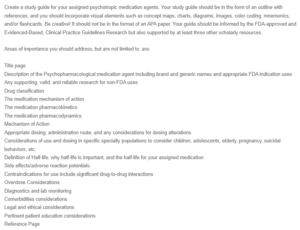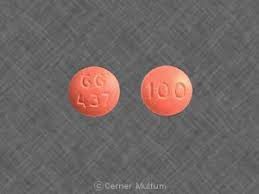Study Guide for Medication Treatment Schizophrenia Spectrum and Other Psychosis Disorders – Chlorpromazine
Schizophrenia spectrum disorders are a major health concern. Despite having a relatively low prevalence compared to other behavioral disorders, these conditions have been implicated in significant comorbidities with other medical and psychiatric conditions. Their heterogeneity and complexities make managing them difficult. Notwithstanding, several agents exist that are effective in relieving the symptoms of these diseases. First-generation antipsychotic agents such as chlorpromazine have long been used in managing schizophrenia spectrum disorders (Remington et al., 2017). This study guide details chlorpromazine, detailing its handling aspects, indications, and administration information.
Description of the Psychopharmacological Medication Agent
Chlorpromazine is a medication belonging to the antipsychotic class of medications. It is used primarily to manage schizophrenic disorders but can also be used in the management of bipolar disorders, persistent singultus, and acute intermittent porphyria. It is also used to control intraoperative nausea, vomiting, and acute agitation. Off-label, this medication is used adjunctively to treat serotonin syndrome and to manage nausea and vomiting associated with nausea and vomiting.
The generic name of the medication is chlorpromazine. The available brands include Thorazine, Ormazine, Largactil, and Sonazine, among others. Chlorpromazine tablets are available in 10 mg, 25 mg, 50 mg, 100 mg, and 200 mg strengths. Intramuscular and intravenous injection formulations also exist.
Supporting, Valid, and Reliable Research for Non-FDA Uses
Chlorpromazine is approved for use off-label in managing nausea and vomiting associated with migraine and as an adjunct in the management of serotonin syndrome. Several studies have reported the effectiveness of high-dose chlorpromazine in the management of serotonin syndrome. Francescangeli et al. (2019) postulate that chlorpromazine at high doses can help in the prevention of hyperthermia and lethality in serotonin syndrome, owing to their antagonism with the 5HT-2A receptors. This medication is only preferred when benzodiazepines fail to address agitation in patients with serotonin syndrome.
Chlorpromazine is also effective in managing nausea and vomiting associated with migraine. This medication has been used in the management of acute migraine attacks. Edinoff et al. (2022) note that chlorpromazine use has been associated with considerable reductions in pain, phonophobia, photophobia, nausea, and the need for initiating a rescue medication at one hour. This highlights its usability in migraine associated with nausea.
Drug Classification
Chlorpromazine is a phenothiazine antipsychotic. It is a first-generation antipsychotic agent typically used primarily to manage positive symptoms of schizophrenia.
The Medication Mechanism of Action
Chlorpromazine produces its antipsychotic effects through its antidopaminergic, antimuscarinic, antihistaminic, and alpha-adrenergic blockade activities. It blocks D2 receptors in the mesolimbic pathways resulting in a low dopamineergic activity in the brain. This causes considerable reductions in agitation and aggression that usually characterize psychotic disorders (Stip et al., 2020). The alpha-adrenergic blockade and antimuscarinic effects of chlorpromazine also aid in establishing tranquility in psychotic patients. Histaminin, muscarinic, and dopaminergic blockade actions of chlorpromazine are responsible for its antiemetic properties allowing it to be used in vomiting and nausea associated with psychotic conditions and other disorders. Its antimuscarinic activities further help in reducing salivary and gastric secretions that are sometimes prominent in psychotic conditions.
The Medication Pharmacokinetics
Chlorpromazine is available in tablet formulations, as well as intramuscular and intravenous injections. Upon administration of chlorpromazine tablets, it is rapidly absorbed with an onset of activity of between 30-60 minutes. This medication has a bioavailability of about 30% and a peak plasma concentration occurring between 2 to three hours.
Chlorpromazine has a protein binding of 98%. Its high lipid solubility makes it have a wide volume of distributions. It highly diffuses across the placenta, and small quantities have been found in breast milk. It is metabolized in the liver by the microsomal enzymes, specifically CYP1A2 and CYP2D6. This medication also undergoes some metabolism in the GI tract and the kidneys. Chlorpromazine is eliminated via bile and urine.
The Medication Pharmacodynamics
Chlopromazine has antidoperminergic, antimuscaribic and antihistaminic activities. Its antidoperminergic activities confer its antiemetic properties and inform its use in managing nausea and vomiting. Its antihistaminic properties make it a mild anti-pruritic agent. The dopamine blockade effects of chlorpromazine stimulate prolactin secretion. Chlorpromazine is also an inhibitor of prolactin-release inhibitory factor. These actions may manifest as galactorrhea in patients taking the medication.
Appropriate Dosing, Administration Route, and Any Considerations for Dosing Alterations
Chlorpromazine is available in tablet formulations and for IM and IV injectable routes. In the management of schizophrenia, the starting dose of chlorpromazine is between 25 and 75 mg administered orally every 12 hours. A maintenance dose of 200mg is recommended. A dose of 25 mg administered orally every 4-6 hours is recommended for the management of nausea and vomiting. For patients with intractable hiccups, administering 25 mg orally every 4-6 hours may be helpful (Remington et al., 2017)l. No dosing adjustments or alterations are necessitated for patients undergoing dialysis (Leucht et al., 2020). Further, dose reduction may be necessitated for patients with significant hepatic impairment requiring the medication.
Considerations of Use and Dosing
Chlorpromazine can be used safely in children aged six months and above. However, its safety and efficacy in children below six months is yet to be established. Its use among adolescent populations is safe and efficacious. Furthermore, the medication is not recommended in pregnancy as it has been associated with harmful effects in animals. Its safety during human pregnancy has also not yet been proven. The medication, in this respect, can only be used in pregnant women if its benefits outweigh the risks. A small amount of chlorpromazine is excreted in the breast milk. It is thus not recommended for breastfeeding mothers to use this medication. Chlorpromazine does not influence suicidality and can thus be used even by patients who are at high risk of committing suicide. However, due to the higher potential for second-generation agents to prevent suicide, it is recommended that patients with suicidal behaviors be put on second-generation antipsychotics.
Definition of Half-Life, Why Half-Life Is Important
Half-life refers to the time taken for the amount of an active substance to reduce by half. It is useful in determining the excretion rates of a drug and may inform dosing considerations. Chlorpromazine has a half-life of between 23-37 hours.
Side Effects/Adverse Reaction Potentials
The common side effects of chlorpromazine include GI disturbances, drowsiness, dizziness, blurred vision, dry mouth, impotence, and urinary retention. It can also cause gynecomastia, galactorrhea, prolonged QT intervals, and irregular menstruation (Muhieddine et al., 2019).
Contraindications
Chlorpromazine is contraindicated in known hypersensitivity, bone marrow depression, hypothyroidism, history of agranulocytosis, Myasthenia gravis, Phaeomochromocytoma, and in patients at high risk of narrow-angle glaucoma.
Overdose Considerations
Overdose of chlorpromazine often manifests as hypotension, loss of consciousness, hypothermia, Parkinsonian, ventricular arrhythmias, and coma. Treatment is symptomatic as there is no antidote.
Diagnostics and Lab Monitoring
LFTs may be necessary when chlorpromazine is administered via the IM and IV routes due to the high potential for drug-induced hepatotoxicity. Regular BP measurements may also be necessary due to the high potential for hypotension.
Comorbidities Considerations
Chlorpromazine is used in the management of several psychiatric disorders. Its use is acceptable in patients with psychotic comorbidities.
Legal and Ethical Considerations
Chlorpromazine is a prescription-only medication. When using this medication, a legal consideration to be taken into account is restrictive prescribing. Only authorized persons by law are allowed to prescribe and or refill these medications for patients with their indication. This better guarantees patient safety as it ensures that only caregivers knowledgeable about the medications are allowed to administer them. Ethical considerations are beneficence and non-maleficence. Beneficence requires caregivers to protect the welfare of their patients, while non-maleficence requires caregivers to protect them from harm’s way. These include taking all necessary precautions against overdose and misuse of medications. Due to its potential for side effects and lethality due to overdose, appropriate patient education should accompany the issuance of chlorpromazine to the patients.
Pertinent Patient Education Considerations
Patients on chlorpromazine should be educated on the need to adhere to the medication for relapse prevention. Medication adherence provides a better assurance of symptom relief, relapse prevention, and quality of life. Additionally, they should be educated on dosing considerations to prevent any potential for overdose. Overdose with chlorpromazine may result in death if not managed appropriately. Educating the patients on the potential side effects is also necessary due to the high potential of this medication to produce some side effects on the patients. This medication has profound side effects, some of which are detrimental.
References
Edinoff, A. N., Armistead, G., Rosa, C. A., Anderson, A., Patil, R., Cornett, E. M., Murnane, K. S., Kaye, A. M., & Kaye, A. D. (2022). Phenothiazines and their evolving roles in clinical practice: A narrative review. Health Psychology Research, 10(4). https://doi.org/10.52965/001c.38930
Francescangeli, J., Karamchandani, K., Powell, M., & Bonavia, A. (2019). The serotonin syndrome: From molecular mechanisms to clinical practice. International Journal of Molecular Sciences, 20(9), 2288. https://doi.org/10.3390/ijms20092288
Leucht, S., Crippa, A., Siafis, S., Patel, M. X., Orsini, N., & Davis, J. M. (2020). A dose-response meta-analysis of antipsychotic drugs for acute schizophrenia. American Journal of Psychiatry, 177(4), 342–353. https://doi.org/10.1176/appi.ajp.2019.19010034
Muhieddine, D., Moughnié, M., & Abdel-Razzak, Z. (2019). Short communication: Chlorpromazine causes a time-dependent decrease of lipids in saccharomyces cerevisiae< Interdisciplinary Toxicology, 12(1), 41–44. https://doi.org/10.2478/intox-2019-0006
Remington G, Addington D, Honer W, Ismail Z, Raedler T, Teehan M. Guidelines for the pharmacotherapy of schizophrenia in adults. The Canadian Journal of Psychiatry. 2017;62(9):604-616. https://doi.org/10.1177/0706743717720448
Stip, E., Rizvi, T. A., Mustafa, F., Javaid, S., Aburuz, S., Ahmed, N. N., Abdel Aziz, K., Arnone, D., Subbarayan, A., Al Mugaddam, F., & Khan, G. (2020). The large action of chlorpromazine: Translational and transdisciplinary considerations in the face of COVID-19. Frontiers in Pharmacology, 11. https://doi.org/10.3389/fphar.2020.577678
ORDER A PLAGIARISM-FREE PAPER HERE
We’ll write everything from scratch
Question
Create a study guide for your assigned psychotropic medication agents. Your study guide should be in the form of an outline with references, and you should incorporate visual elements such as concept maps, charts, diagrams, images, color coding, mnemonics, and/or flashcards. Be creative! It should not be in the format of an APA paper. Your guide should be informed by the FDA-approved and Evidenced-Based, Clinical Practice Guidelines Research but also supported by at least three other scholarly resources.

Study Guide for Medication Treatment Schizophrenia Spectrum
Areas of importance you should address, but are not limited to, are:
Title page
Description of the Psychopharmacological medication agent including brand and generic names and appropriate FDA indication uses
Any supporting, valid, and reliable research for non-FDA uses
Drug classification
The medication mechanism of action
The medication pharmacokinetics
The medication pharmacodynamics
Mechanism of Action
Appropriate dosing, administration route, and any considerations for dosing alterations
Considerations of use and dosing in specific specialty populations to consider children, adolescents, elderly, pregnancy, suicidal behaviors, etc.
Definition of Half-life, why half-life is important, and the half-life for your assigned medication
Side effects/adverse reaction potentials
Contraindications for use include significant drug-to-drug interactions
Overdose Considerations
Diagnostics and lab monitoring
Comorbidities considerations
Legal and ethical considerations
Pertinent patient education considerations
Reference Page


